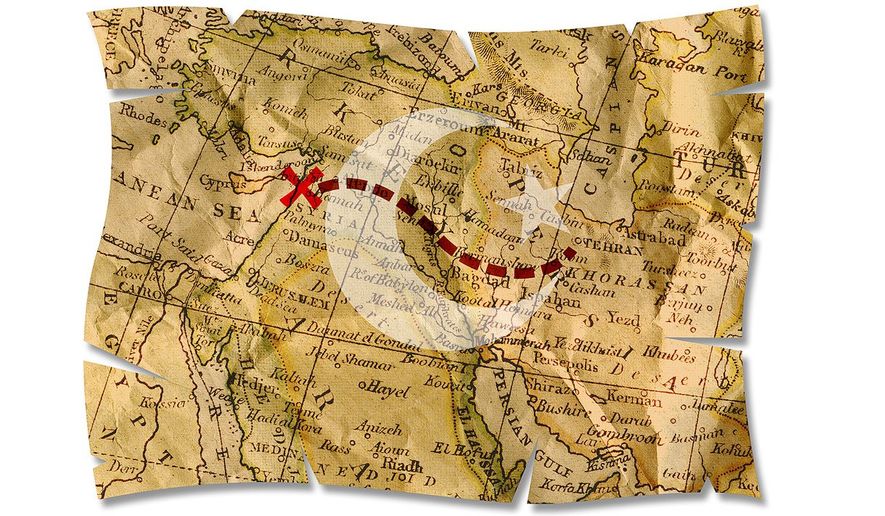OPINION:
Things are quickly changing on the ground in Syria. The civil war is concluding, with Bashar Assad still in power. As the U.S.-backed coalition drives the Islamic State from its remaining strongholds, Iranian-backed forces are racing to fill the void, seizing strategic territory with the goal of making Syria the heart and possibly the Iranian logistical center of a “Shia Crescent” — replete with land, air and naval bases — creating an Iranian sphere of influence stretching from Tehran through Baghdad and Damascus to Beirut and the Mediterranean.
This Iranian land bridge facilitates movement of Iranian-backed fighters and weapons between Iran, Iraq, Syria and Lebanon. Such a corridor expands Iran’s dominance in the region and empowers Hezbollah, now armed with tens of thousands of Iranian missiles. Syrian Information Minister Mohammad Ramez Tourjman boasted in a TV interview, “The aim is for a geographical connection between Syria, Iraq and the axis of resistance [Iran and Hezbollah].”
At least 18,000 fighters allied with Iran are present in Syria at any given time, a number that includes about 5,000 Hezbollah terrorists and 1,500 Iranian military personnel. Five-thousand tons of armaments have passed between Tehran and Damascus in the past few years. Iranian armament production infrastructure, including long-range missile manufacturing plants, is being set up in Syria. And Iran is working to control border areas between Syria and Iraq to allow it to transport fighters and captured Iraqi advanced weaponry from Iraq to Syria.
In early July, the Trump administration supported a series of Russia-U.S.-brokered cease-fires in western Syria. These de-escalation agreements failed to address Iranian presence on Syrian terrain post-conflict.
The United States hasn’t begun to formulate a final status policy for the postwar period and, with respect to the issue of Iran’s presence in Syria, it is sending mixed signals. Secretary of State Tillerson has said that Iran’s Islamic Revolutionary Guard Corps (IRGC) and its foreign proxies (Hezbollah) “must leave and go home” as part of any eventual resolution of the Syrian conflict. But representatives of the U.S. military recently commented that the U.S. coalition’s mission is solely focused on defeating ISIS in Iraq and Syria and welcomed a push by IRGC-allied forces to seize oil-rich ISIS strongholds in the all-important Iraq-Syria border region, part of any Iranian land bridge.
America’s current strategic incoherence about Iran’s designs in Syria is of great concern — especially to Israel.
Israeli Prime Minister Benjamin Netanyahu sent a top-level security delegation to provide U.S. policy planners with detailed intelligence about the significant spread of Iranian influence in Syria. Their message: “We rushed here to warn of the deployment of Hezbollah, Iranian and Syrian forces. Without a significant change in your position, if you don’t become more involved, tougher and more aggressive, you will leave the Middle East to the Iranians, under Russian auspices.” The Americans didn’t commit to demanding the evacuation of Iranian and Hezbollah forces from Syria in the aftermath of the war.
Mr. Netanyahu then held a sit-down with Russian President Vladimir Putin and remarked, “The victory over ISIS is welcome,” but warned that “Iran is increasing its efforts to establish its military foothold in Syria. That is dangerous for Israel, the Middle East and the whole world. Iran is already in advanced stages of taking over Iraq and Yemen, and in effect it also controls Lebanon.” Apparently, Mr. Putin listened, noted Israel’s concerns, but offered no commitments.
Israel made it clear to both parties that it cannot tolerate an Iranian land corridor stretching from Tehran to the Golan Heights and, if the U.S. and Russia fail to act to remove Iran and Hezbollah, Israel is ready to act unilaterally to prevent Iran from establishing a presence on its northern border and enhancing its ability to strike Israel.
Israel fears that, in the end, the Russians and the Americans will come to an agreement without formulating broader arrangements that delineate how Syria should look after the civil war is over.
While the Trump administration is focused on North Korea, Afghanistan, Pakistan and the Israel-Palestinian issue, Iran is creating facts on the ground, which seem to be flying under the U.S. radar. If President Trump doesn’t focus like a laser on Iran, his impending defeat of ISIS in Syria will backfire, opening the door to greater instability in the Middle East.
The Trump administration’s inaction on the Iranian issue will help ensure that the Obama policy of promoting Iranian dominance in the Middle East becomes reality. It’s time to deal with the gathering Iranian menace in Syria before it’s too late.
• Ziva Dahl is a fellow with the Haym Salomon Center.




Please read our comment policy before commenting.